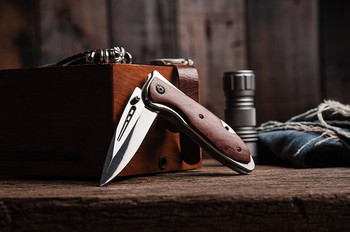Popular Locking Mechanisms for Folding Knives
Posted by Clayton on Dec 25th 2012
When you buy a folding knife, the locking mechanism is of utmost importance for obvious safety reasons as well as open and closing functionality. The blade swings open 180 degrees and must lock in place if you want to achieve safe cutting techniques. The same can be said for closing or folding a knife in that is must remain in the closed position while not in use. If you are new to the knife world then you may be puzzled about how your new pocket knife blade actually functions.
Here is an overview of the most popular knife locking mechanisms you will encounter with today's pocket knives.
Liner Lock (Locking Liner)
The "liner lock" is easily the most popular locking style on today's folding knives and has been since it's inception by Michael Walker in 1980. When the blade of a folding knife is in the open position (it will click), a leaf spring (lock bar) presses against the tang of the blade to prevent it from closing. To close, you must press the locking bar back toward the handle side of the knife (the left) which will release the lockbar.
Note: In the closed position the lockbar rests in between the handle and blade.
The locking liner is prevalent in most tactical knives and assisted knives (one hand opening) you see today. Examples are Zero Tolerance, Kershaw and CRKT.
Slip Joint
A mechanism found most commonly on traditional pocket knives where the open blade does not actually lock but is held open by a spring load bar which applies pressure to the base of the blade next to the pivot point. When the blade is in the open position the force of the spring bar keeps the blade open. The blade will fold when enough pressure is applied to it and thus is held closed by the same mechanism. Think of a kickstand on a bicycle. A good example of the "slip joint knife" would be Swiss Army knives as well as Bear & Sons.
Frame Lock (Integral Lock)
Custom knifemaker Chris Reeve invented the "frame lock" to be his updated version of the liner lock. The frame lock functions like the liner lock however, instead of utilizing a separate lock bar, it uses the actual frame which is also spring loaded to hold the blade in place. He decided to call in "integral lock".
When the blade is opened the spring loaded frame lock slides over and presses against the blade locking it in place. It works in much the same way as the liner lock in that you must press the "frame bar" to the left to release the blade to fold back into the handle. Popular with brands like Kershaw, Zero Tolerance, Boker and Chris Reeve Knives.
Mid Lock
The mid lock is essentially a back lock positioned at the middle of the knife spine instead of the back. This gives added strength for the blade lock and allows the blade to withstand more pressure than the back lock. Cold Steel is an avid proponent of the mid lock.
Lock Back (Back Lock)
One of the very first folding knife locking mechanisms and probably the most popular. The back lock can be found on most of the pocket knives your parents and grandparents carried over the years.
A simplistic approach to knife locks, the lock back locks into place when opened and works by pressing a lock plate or latch which activates the spring on the back of the handle spine which releases the blade allowing it to close.
When opened the spring loaded small locking liner locks against the blade to keep open. Very popular with pocket knife brands such as Buck, SOG and Case.
Button Lock
This is used mainly for automatic opening (switch blade) knives. When the push button is pressed the blade releases quickly. Banned in most states and countries.
Axis Lock
The Benchmade Knife Company licensed a locking mechanism called the "AXIS" their patented locking technology that has ambidextrous use. According to Benchmade.com
AXIS® gets its function from a small, hardened steel bar which rides forward and back in a slot machined into both steel liners. The bar extends to both sides of the knife, spans the liners, and is positioned over the rear of the blade. It engages a ramped, tang portion of the knife blade when it is opened. Two omega style springs, one on each liner, give the locking bar its inertia to engage the knife tang. As a result, the tang is wedged solidly between a sizable stop pin and the AXIS® bar itself. Available in manual, assist or automatic configurations.
Arc Lock
SOG specialty knives created the "arc lock" which rivals the axis from Benchmade except SOG uses a rotary spring for tension instead of an axial spring used by BM.

